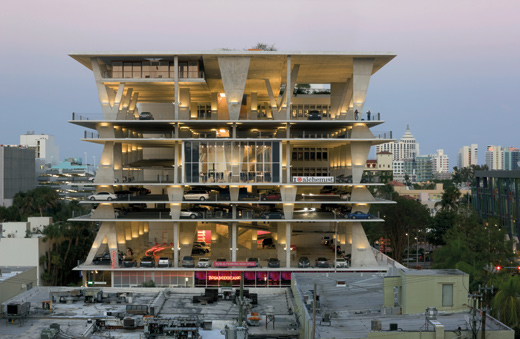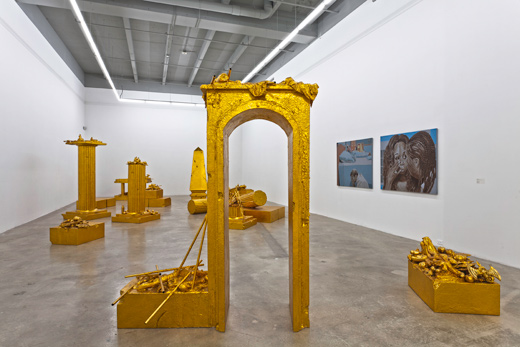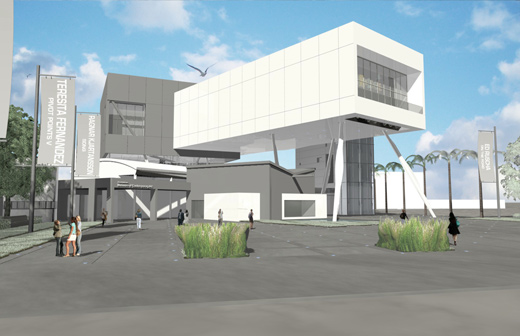
Herzog & de Meuron’s 1111 Lincoln Road. Photo courtesy of Duccio Malagamba and MBEACH1, LLLP.
Driven everywhere, I never got lost in the city’s rampant sprawl. Its distinctive yet agglomerated neighborhoods and block by block shifts from deluxe to third world swiftly became more intriguing than unnerving. This relaxing, democratic hodgepodge of architecture seemed to mirror the Miami art world’s social porosity. From the super-affluent collectors to gallerists to the staffs of museums — no less the impressive wave of newly-arrived artists, curators, performers, and writers — everyone seemed to be on a first name basis. It helps that the core arts community within this expansive, intercontinental city probably numbers less than 400 people, and many Miamians I met seemed to have known each other for decades and had left at one point, only to be drawn back.
Much of the city’s pulsating art world is a byproduct of the decade-old Art Basel Miami Beach. There are now over 150 art galleries and spaces in Miami’s assembled communities, although many only function fully in the weeks around Art Basel. When asked, local art experts will say only a handful of these galleries are any good, although there is no shared consensus as to which ones.
The 200 serious artists practicing in Miami — about the same number as in Brooklyn around the turn of the millenium — are both laid-back and serious. Though very few of the city’s artists seem to sell enough art to live on, none appear bitter that the city’s major art fairs and collectors largely ignore them. Clearly, sunshine and cheap rents for large studios assuage this neglect.
For a city of about 430,000 (within the fifth-largest urban area in the United States, total population 5.5 million), Miami remarkably has seven art museums along with four major art spaces created by contemporary collectors. These personally funded, open to the public collections are considerably larger, more solidly budgeted, and feature more rigorous programming than most US contemporary art institutions — offering tours and broad educational outreach as part of their missions. However, basing culture around private collections and personal taste is not without its perils. The de la Cruz Collection Contemporary Art Space will not, according to Rosa de la Cruz’s current thinking, stay open after her death. Likewise, it seems doubtful that Martin Margulies’s sprawling warehouse art spaces will continue after their voracious proprietor’s lifetime. The Cisneros Fontanals Art Foundation (CIFO) is a much quieter player a decade after its opening. Also, the exhibit I saw at the Rubell Family Collection, American Exuberance, was more of a recent acquisitions and gifts from other collectors shout-out than a selective exploration of its stated topic. (That said, the Rubell Family space seems best positioned for the long-term, as there is a next generation of avid art collectors and it, alongside CIFO, is a 501©(3) non-profit.) Furthermore, few works by Miami artists are featured in these collectors’ spaces, except the de la Cruz’s ongoing Miami artist installation space from which purchases have not been made. And while these key private collectors have generously given art works and substantial funds to the city’s existing art museums, none of them, so far as one knows, have yet pledged their vast holdings, which number in aggregate close to 20,000 works of art, to any of Miami’s museums.

John Miller, “A Refusal to Accept Limits,” 2007. Photo courtesy of Rubell Family Collection.
The past, they say, is a foreign country. Since Fidel Castro’s rise to power in the late 1950s, Cuba’s political history and present deeply shade Miami. That shadow was apparent in a couple of ways during my visit. At the de la Cruz space, an installation and documentary film about the dissident Cuban blogger Yoani Sanchez was on view. It was clearly more about politics than art, as is the current firestorm about the thirty-five million dollar money and art donation (the value of which is broadly questioned) given to the Miami Art Museum by the local real estate magnate Jorge M. Pérez. Turning the Miami Art Museum (MAM) into Pérez Art Museum Miami (PAMM) obviously disregards the county’s taxpayers, who voted in 2005 to allot $100 million to help the museum pay for its high-profile new home, slated to open for the next Art Basel.
The Museum of Contemporary Art, North Miami, led by the ceaselessly au courant Bonnie Clearwater, is also poised to expand. The area’s most consistently rigorous and provocative contemporary curatorial program will soon float a new upper story above its present white box space, all the while located in a neighborhood that makes MoMA PS1 look like it is in Midtown Manhattan.
Over the last 25 years, much of what has been accomplished for the arts in Miami has derived from the Miami-Dade County Department of Cultural Affairs, whose long-time leader Michael Spring oversees an annual budget of more than $24 million and a staff of 26. Serious support for gifted area high school and college students, with such inspiring programs as the New World School of the Arts and Lin Arison’s Miami-based YoungArts, rivals what is done in New York City. But above all, the John S. and James L. Knight Foundation has recently been the area’s biggest game changer. Countering the recession, culture in Miami has received nearly four million dollars of Knight Foundation grants, going to a wide array of cultural and educational entities.
While my short visit was visual arts-centric, I did meet writers with a different understanding of social media. Lester’s, an art and literary café in Wynwood, the stylish yet modest Books & Books chain of indie-bookstores, and the conceptual University of Wynwood, whose mission is “to curate an imaginary Miami through the context of contemporary literature,” are welcome outposts for community conversation. Manifesting the city’s scant degrees of separation, the University of Wynwood shares an office with the Borscht Film Festival and Coral Morphologic, whose scientific and artistic exploration of living coral reef organisms via site-specific artworks and HD videography radiated the most beautiful and unexpected work I saw.

Rendering of the planned addition to the Museum of Contemporary Art, North Miami. Photo courtesy of MoCA.










